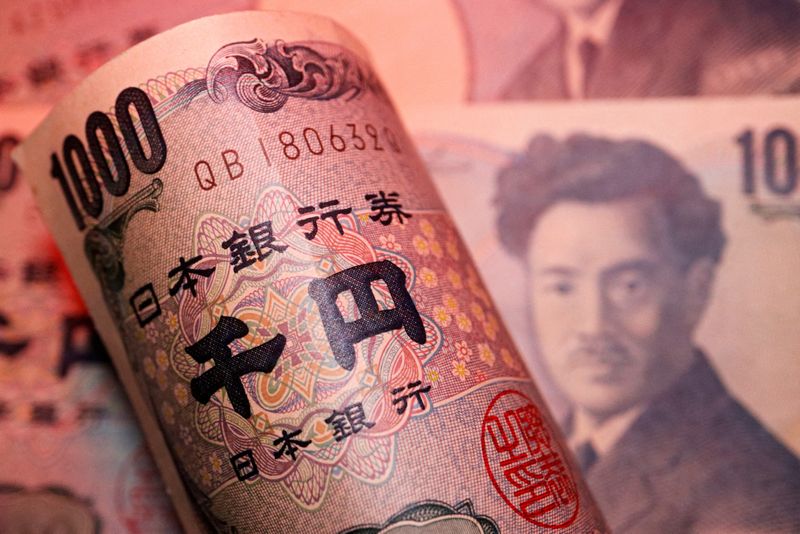Forex
Pound rises after UK inflation data, yuan hits 9-month low


© Reuters. Banknotes of Japanese yen are seen in this illustration picture taken September 22, 2022. REUTERS/Florence Lo/Illustration/file photo
By Samuel Indyk and Rae Wee
LONDON (Reuters) – The pound was on track for its biggest one-day gain in almost two weeks on Wednesday after data showed British core inflation stayed strong in July, while the yuan slipped to a nine-month trough as concerns mounted about the extent of China’s slowdown.
The yen was weak, hovering in an intervention zone that last year triggered intervention, but the New Zealand dollar was supported after the central bank raised the prospect of a slight delay to when it would start to cut borrowing costs.
The pound hit a high of $1.2768 and was last up around 0.3% at $1.2741, set for its biggest one-day jump since Aug. 4.
Core inflation in Britain, which strips out volatile energy and food prices, remained at 6.9% in July, flat versus the June reading, and higher than expectations in a Reuters poll for a reading of 6.8%.
With inflation still exceeding the Bank of England’s 2% target, the central bank is expected to raise rates further even at the risk of hurting growth, analysts said.
“Core inflation and services inflation are too high. It all indicates that the Bank of England will have to move rates higher in September,” said Niels Christensen, chief analyst at Nordea.
“I’m surprised it (sterling) hasn’t gained more ground. (The market is) locked between hike expectations supporting sterling and fear of a weaker economy weighing on sterling.”
CHINA WORRIES MOUNT
In Asia, the yuan touched its lowest level since November in both the onshore and offshore markets, falling to as low as 7.2989 per dollar, and hitting a trough of 7.3379, respectively.
That extended Tuesday’s decline following Chinese data that missed forecasts and prompted Beijing to deliver unexpected cuts to its key policy rates as authorities there sought to shore up an economy that has rapidly lost steam in recent months.
The Australian dollar, often used as a liquid proxy for the yuan, plumbed nine-month lows in response to the Chinese data.
“Seeing is believing. The markets still want to see much more tangible evidence of not just monetary, but fiscal support coming through to revive growth (in China),” said Ray Attrill, head of FX strategy at National Australia Bank (OTC:).
“Until they see any evidence of that, they’re still going to take the view that not enough is being done or that China isn’t sufficiently serious about bolstering growth to really bring about a meaningful shift in sentiment,” he said, adding he expected downward pressure on the Australian dollar to persist for now.
The New Zealand dollar, which had also fallen to a nine-month low of $0.5932 in early Asian trade, rebounded after the Reserve Bank of New Zealand policy meeting, to trade higher by 0.3% at $0.5966.
The central bank held its cash rate steady as expected on Wednesday, but slightly pushed out when it expects to start cutting borrowing costs to 2025.
“The statement gave a clearly more hawkish tone, likely defying any dovish expectations,” said Barclays (LON:) research analyst Shreya Sodhani.
“We think today’s more hawkish statement and the governor’s press conference suggest that the timing of rate cuts will likely be pushed back a bit.”
The was off 0.1% at 103.11, though it was not far from an over one-month peak hit on Monday, driven by higher bond yields following upbeat U.S. data. The euro gained 0.1% to $1.0916.
Elsewhere, a sliding yen kept traders on intervention watch. The currency has hit the key 145 per dollar level for four sessions now, a zone that triggered heavy dollar selling by Japanese authorities in September and October last year.
“Markets are concerned whether the Bank of Japan will intervene or whether dollar-yen needs to go all the way up to 150,” Nordea’s Christensen said.
“They have not been so loud in the last week but the threat of intervention is why the market has been a little bit hesitant to push dollar-yen up.”
Policymakers’ rhetoric against defending a weakening yen has been less robust than last year. Finance Minister Shunichi Suzuki said on Tuesday authorities were not targeting absolute currency levels for intervention.

 Forex3 years ago
Forex3 years agoForex Today: the dollar is gaining strength amid gloomy sentiment at the start of the Fed’s week

 Forex3 years ago
Forex3 years agoUnbiased review of Pocket Option broker

 Forex3 years ago
Forex3 years agoDollar to pound sterling exchange rate today: Pound plummeted to its lowest since 1985

 Forex3 years ago
Forex3 years agoHow is the Australian dollar doing today?

 Cryptocurrency3 years ago
Cryptocurrency3 years agoWhat happened in the crypto market – current events today

 World3 years ago
World3 years agoWhy are modern video games an art form?

 Commodities3 years ago
Commodities3 years agoCopper continues to fall in price on expectations of lower demand in China

 Economy3 years ago
Economy3 years agoCrude oil tankers double in price due to EU anti-Russian sanctions





















